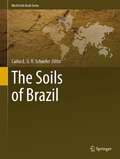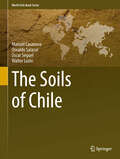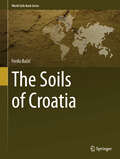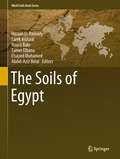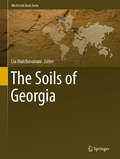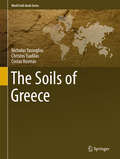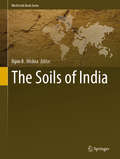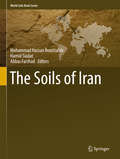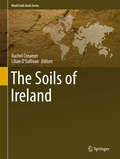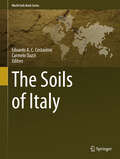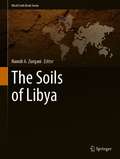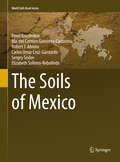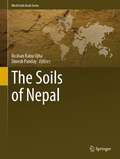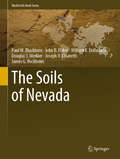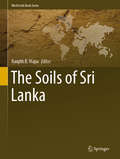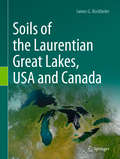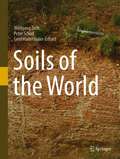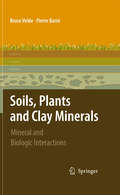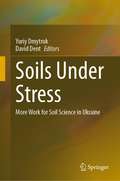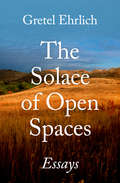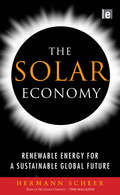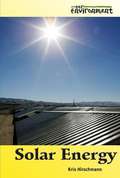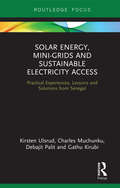- Table View
- List View
The Soils of Brazil (World Soils Book Series)
by Carlos E. G. R. SchaeferThis book represents the first comprehensive edition, in English, on the soils of Brazil, in the challenge of illustrating all the biomes of a country of truly continental dimension. In addition to presenting the first geosystemic view of Brazilian soils, in all geological, geomorphological and environmental aspects, the book also makes a key contribution to the discussion of current topics in Pedology, such as Anthrosols, Technosols, Soil Management trends and sustainability, Pedometrics and advanced techniques of digital soil mapping. The soils of Brazil were conveniently stratified into sectors and treated within the different biomes, without neglecting any area of the Brazilian territory. Considering the aspects of the landscape of occurrence, climates, geomorphology and geology, each pedological region was abundantly documented with soil profile data and many fine original, three-dimensional illustrations and diagrams, made with care by the authors. Among the regions, the most important are the forested Amazon, the Central Plateau with Cerrados, the Caatingas of the northeastern semi-arid region, the Atlantic Forest in all known variants; in addition, the Restingas, Mangroves, Oceanic Islands, Wetlands of the Pantanal and the subtropical regions of the Pampa and Matas de Araucaria. The book is of great importance as the first published work on Brazilian soils, but it is of great interest to geologists and geomorphologists who study the tropics and subtropics, due to the novelty and scope of the work.
The Soils of Chile
by Manuel Casanova Oscar Seguel Osvaldo Salazar Walter LuzioThis book is intended for students and soil scientists who want to know about the state of the art in soil sciences in Chile. The book merges a comprehensive bibliographical review of the soil surveys carried out throughout the length and breadth of Chilean territory during the past 40 years and more recent information obtained by the authors in a number of field studies. As its starting point the book presents a general overview of important features related to Chilean soils, such as geology and geomorphology, climate, land use and vegetation. In this long and narrow country different soil formation factors and processes have resulted in a broad variety of soil bodies, from the extremely arid Atacama desert to the Patagonian and Antarctic zones. This book provides a description and classification (mainly Soil Taxonomy) of the most important soil types. Particularly important are soils derived from volcanic materials, which cover extensive areas of Chile. The book also deals with soil management topics in relation to the chemical, physical and biological properties of Chilean soils and it includes a number of examples from throughout the country. Finally, the book shows how man has induced severe soil degradation problems in Chile, such as erosive soil degradation, non-erosive soil degradation and land desertification.
The Soils of Croatia
by Ferdo BašićThe Soils of Croatia is a six-chapter book detailing all aspects of Croatian soils. The book presents, in a reader friendly way, the lively history of pedology in Croatia. It explains soils as natural resources for this country and offers a detailed view on the different agricultural regions referenced in Croatia. The Soils of Croatia also contains useful information regarding the different factors of soil genesis in the different regions as well as on soil taxonomy and it gives a very detailed classification of different Croatian Soils. Overall, this book contains everything that pedologists, students and anyone else interested in Croatian soils should know about.
The Soils of Egypt (World Soils Book Series)
by Hassan El-Ramady Tarek Alshaal Noura Bakr Tamer Elbana Elsayed Mohamed Abdel-Aziz BelalThis book reviews the distribution of soils across Egypt, their history, genesis, pollution and management. The conservation of Egyptian soils, soils and their connections to human activities, as well as some future soil issues are also highlighted. It is well known that soil is the main source for food, feed, fuel and fiber production. Accordingly, the study of soils is not only a crucial issue but also an urgent task for all nations worldwide. Due to their important roles in agroecosystems as well as many aspects of our lives, soils have direct and indirect functions in the agricultural, industrial and medicinal sectors. Therefore, understanding the physical, chemical and biological properties of soils, as well as soil security, have now become emerging issues. Climate change has a very dangerous dimension in Egypt concerning the rising sea level. Many coastal zones are already threatened by this sea level rise, and may ultimately disappear. At the same time, water shortages and soil pollution represent the main challenges for the Egyptian nation. Generally speaking, the environmental challenges that Egypt now faces include improving and sustaining soil health, soil carbon sequestration, wastewater treatment, and avoiding the overuse of fertilizers and pesticides. Therefore, this book examines in detail the soils of Egypt from various perspectives including their genesis, history, classification, pollution and degradation, soil security, soil fertility and land uses.
The Soils of Georgia (World Soils Book Series)
by Lia MatchavarianiThis book provides an extensive overview of the diversity of soils in Georgia. It highlights the soil-forming environment (climate, geology, geomorphology), the characterization of the physical, chemical and morphological (macro-, micro-) properties of soils, the history of soil research in Georgia, and the geographic distribution of different soil types. In addition to describing the soil cover, the book also zones and classifies the soils. Past and current land use issues, ecological properties and implications of soils, and many other aspects are elaborated on; special attention is paid to anthropogenic soil degradation due to the contamination and erosion of soils in Georgia. This comprehensive and richly illustrated book, which includes a wealth of pictures and soil maps, offers an essential field guide for soil scientists, geographers and researchers in related areas.
The Soils of Greece
by Nicholas Yassoglou Christos Tsadilas Costas KosmasThis book presents a comprehensive and up-to-date overview on soils of Greece. It includes sections on soil research history, climate, geology, geomorphology, major soil types, soil maps, soil properties, soil classification, soil fertility, land use and vegetation, soil management, soils and humans, soils and industry, future soil issues. The book summarizes what is known about the soils in Greece in a concise and highly reader-friendly way.
The Soils of India (World Soils Book Series)
by Bipin B. MishraThis book provides an overview of the diversified soil regimes in India. In addition to the historical advances in soil research and its limitations, it describes the monitoring of various soil conditions and soil uses to improve productivity. Discussing topics such as climate, geology and geomorphology, major soil types and their classification, soil mineralogy and clays, soil micromorphology, soil biogeochemistry, benchmark soils, land evaluation and land use planning, soil health and fertility and soil resilience, the book highlights the multiple uses of soils in industry, human health care, mitigation of challenges due to climate change and construction. It also presents measures for a brighter future of soil science in India, such as imposing organic farming principles toward sustainable agriculture in the context of the second green revolution besides alleviating the poverty and providing the employment opportunities among the farming communities in India.
The Soils of Iran (World Soils Book Ser.)
by Mohammad Hassan Roozitalab Hamid Siadat Abbas FarshadThis unique book addresses Iran’s extremely rich soil diversity and resources, which have developed under various climatic conditions ranging from dry to humid conditions. Featuring contributions by a group of respected experts on Iranian soils and agriculture, it provides comprehensive information on the management approaches needed for sustainable soil utilization and conservation under such conditions, and the attendant challenges. As such, it offers a valuable resource for anyone interested in soils and agriculture in Iran, but also in other Middle East and North African countries with similar climatic conditions. The book contains 14 chapters which illustrate the long history of indigenous knowledge and soil research, climate, geology and geomorphology, vegetation cover, soil forming factors and processes, major soils, properties and their classification. Furthermore, it presents past climate change and paleosols, agroecological zones, soil fertility, soil biology and biotechnology, human induced land degradation and “soil management in space and time”. In the end, major challenges facing the soil resources of the country are defined and recommendations are made to face the future challenges.
The Soils of Ireland (World Soils Book Ser.)
by Rachel Creamer Lilian O’SullivanThis book provides a comprehensive overview of pedology in Ireland. It describes the main soil types of the country, their functions, ecological use, and the conditions to which they were subjected associated with management over time. In addition, it presents a complete set of data, pictures and maps, including benchmark profiles. Factors involved in soil formation are also discussed, making use of new, unpublished data and elaborations. The book was produced with the support and sponsorship of Teagasc, The Agriculture and Food Development Authority, Ireland and the Irish Environmental Protection Agency.
The Soils of Italy
by Carmelo Dazzi Edoardo A.C. CostantiniThe Soils of Italy is the first comprehensive book on Italian pedology in seventy years. Taking advantage of the authors' large experience and of the most up-to-date information and technology, this book treats the main soil types of Italy, their diffusion, their functions, ecological use, and the threats to which they are subjected during centuries of intensive management. It also deals with future scenarios of the relationships between soil science and other disciplines, such as urban development, medicine, economics, sociology, and archaeology. The description of the soils is accompanied by a complete set of data, pictures and maps, including benchmark profiles. Factors of soil formation are also treated, making use of new, unpublished data and elaborations. The book also includes a history of pedological research in Italy, spanning over a century.
The Soils of Japan (World Soils Book Series)
by Ryusuke Hatano Hitoshi Shinjo Yusuke TakataThis book provides an overview of the distribution, properties, and function of soils in Japan. First, it offers general descriptions of the country’s climate, geology, geomorphology, and land use, the history of the Japanese soil classification system and characteristics and genesis of major soil types follow. For each region – a geographic/administrative region of the country – there is a chapter with details of current land use as well as properties and management challenges of major soils. Maps of soil distribution, pedon descriptions, profile images, and tables of properties are included throughout the text and appendices.
The Soils of Libya (World Soils Book Series)
by Hamdi A. ZurqaniThis book presents the soil pedodiversity in Libya. Soils are the source of all life; there can be no life without them. Further, each soil has its own history and its present conditions, which have been shaped by many different factors (e.g. climate, biota, parent material, and relief or topography). The book, divided into eight chapters, provides extensive information on Libyan soils. Chapter one provides an introduction and a broad perspective of the subject, while Chapter two covers the history of soil mapping and research in Libya. Chapter three focuses on local factors of soil formation and describes the geology and climate of the region to explain the diversity of its soils. Chapter four discusses soil classification systems and those most commonly used in the country. The fifth chapter illustrates the constraints and limiting factors that negatively affect agricultural activities across the country. The land cover/land use and the vegetation of the country are described in Chapter six. In turn, Chapter seven presents the status quo of soil biology, the corresponding related research activities, and the other biological properties of Libyan soils. The final chapter (Chapter eight) focus on land degradation and desertification in Libya, emphasizing the main causes, impacts of the phenomena, and efforts to combat it. This book demonstrates the problems that the country is currently facing as a result of climate change, soil erosion, salinization, and pollution, and outlines potential remedies to improve local food security. Bringing together the perspectives and expertise of many distinguished scientists from various universities and institutions in and outside of Libya, the book represents a unique and highly valuable resource.
The Soils of Mexico
by Carlos Omar Cruz-Gaistardo Elizabeth Solleiro-Rebolledo Ma. del Gutiérrez-Castorena Pavel Krasilnikov Robert J. Ahrens Sergey SedovMexico is an extensive country with an extremely complex mosaic of landscapes. The soils of Mexico have still not been completely studied, and there are few publications available on this subject. This book provides a state-of-the-art view on Mexican soils, their geographical distribution, their use and degradation. This is a first attempt to give a systematized characteristic of the soil resources of Mexico. Land resources of the second-biggest economy in Latin America are critical for its sustainable development, and a demand for adequate soil information is high. The information contained within can be used for any soil-related research done in Mexico and in neighboring countries. The book includes detailed characteristics of soils of all the physiographic regions of Mexico with maps, photos and explanatory schemes. The book is based on the experiences of the authors in research and soil survey, as well as on the existent, mainly 'grey' literature on Mexican soils. The book is recommended for researchers and university readers, students of all levels and decision-makers, working in the area of soil science, environmental issues, Earth sciences, land management and nature conservation.
The Soils of Nepal (World Soils Book Series)
by Roshan Babu Ojha Dinesh PandayThis book publishes consolidated information on the soils of Nepal from all possible sources. The Survey Department, Government of Nepal, conducted two national scale soil survey projects to classify soils of Nepal (Land Resource Mapping Project ended in 1985, and National Land Use Planning Project ended in 2021). Both projects adopted the United States Department of Agriculture system of soil classification. Besides, National Soil Science Research Center (previously known as Soil Science Division) of Nepal Agricultural Research Council and Soil Management Directorate, Department of Agriculture, also worked on soils of Nepal. To date, the information on the soils of Nepal is not published in well-documented form but has been reported widely as gray literature (project report or government report) or peer-review articles.'The Soils of Nepal’ is a part of ‘World Soils Book Series’ which constitutes twelve chapters—covering broad aspects such as soil research history, climate, geology, soil classification and mapping, and soil fertility. Furthermore, information about soil properties and relation between soil constituents of the dominant soil types of Nepal and their scope of use in the context of land use are described. This book also tries to simplify the intricate relationship among soil, culture, and people. Each chapter contains a comprehensive, richly illustrated, and up-to-date overview of the soils of Nepal. We believe it fulfils a quest for a global audience including students, educators, extension workers, and soil scientists, who are interested to know the young soils of Nepal.
The Soils of Nevada (World Soils Book Series)
by Paul W. Blackburn John B. Fisher William E. Dollarhide Douglas J. Merkler Joseph V. Chiaretti James G. BockheimThis book discusses Nevada in the context of the history of soil investigations; soil-forming factors; general soil regions; soil geomorphology; taxonomic structure of the soils; taxonomic soil regions; soil-forming processes; benchmark, endemic, rare, and endangered soils; and use of soils.With an average mean annual precipitation of 175 mm (7 in), Nevada is the driest state in the USA. More than three-quarters (89%) of the state has been mapped and the first soil survey was completed in 1909. Nevada is divided into 10 major land-resource areas and features two large deserts (the Great Basin Desert and the Mojave Desert), and over 100 north–south trending enclosed basins separated by mountain ranges (Basin and Range Province), several of which have peaks exceeding 3,400 m. Further, the soils of Nevada represent seven of the 12 globally recognized orders, 29 suborders, 69 great groups, and over 1,800 soil series, and some of the classic research on the origin of duripans and petrocalcic horizons was conducted in the state. This book presents the first report on the soils of Nevada and provides the first soil map of Nevada utilizing soil.
The Soils of Sri Lanka (World Soils Book Series)
by Ranjith B. MapaThis book presents a comprehensive and up-to-date overview of the soils of Sri Lanka. Including sections on the soil research history, climate, geology, geomorphology, major soil types, soil maps, soil properties, soil classification, soil fertility, land use and vegetation, soil management, soils and humans, soils and industry, and future soil issues, the book summarizes the current state of knowledge in a concise and highly reader-friendly way.
Soils of the Laurentian Great Lakes, USA and Canada
by James G. BockheimThis book introduces the reader to the Great Lakes and considers their soil-forming factors and processes, taxonomic structure of the soils, soil geography and pedodiversity, while also addressing the importance and protection of soils in the Great Lakes Coastal Zone. The Great Lakes are an important part of the USA and Canada. Home to 33 million people, including 90% of all Canadians, the Great Lakes account for 20% of the world’s surface freshwater and 90% of the USA’s freshwater. Key industries include shipping, steel and automobile production, energy generation, fishing, pulp and papermaking, agriculture, and recreation. To date, there has been no comprehensive inventory of the region’s soils, which are now subject to dramatic climate change and environmental degradation. This book was prepared using the US Department of Agriculture, Natural Resources Conservation Service databases, including the Web Soil Survey, Soil Series Extent Explorer, soil classification and characterization databases, and county soil surveys, supplemented by shoreline viewer software, the author’s independent research, consultation with colleagues, and survey trips around the Great Lakes.
Soils of the World
by Wolfgang Zech Peter Schad Gerd Hintermaier-ErhardThis book describes and comprehensively illustrates the soils of the world in accordance with the worldwide WRB classification. The structure of the book follows the ecozone concept. For every ecozone, location, climate and vegetation as well as soil formation and distribution are presented. All soils representative of the corresponding ecozone are then described in detail: definition, properties, distribution, use, classification, genesis. Over 260 photographs illustrate soil profiles, soil details and landscapes. Instructive maps and graphs help understand soil properties and soil-forming processes and make the publication an excellent reference book about the world's soils.
Soils, Plants and Clay Minerals
by Pierre Barré Pierre VeldeThis book considers the inter-relations between plants and minerals in an entirely new way, in that it introduces the notion of eco-engineering: i.e. the manipulation of the mineral world by the living world to the ends of the living world. These inter-relations are the basis for traditional agriculture and should be the basis for new, ecologically oriented land management disciplines, including agriculture itself. These relations also have an impact on surface geochemistry and determine pollution problems. A better understanding of this concept will lead to a renewed consideration of surface environmental problems.
Soils Under Stress: More Work for Soil Science in Ukraine
by Yuriy Dmytruk David DentDokuchaev carried out most of his research in Ukraine. His student and friend, Volodymyr Vernadsky, went on to create trans-disciplinary environmental sciences and the concept of Earth as a living organism, famously taken up by James Lovelock. That spring of ideas still flows and the researches captured in this volume are relevant to present-day problems, and not only in Ukraine.Soils have always been under stress but, in the Anthropocene, mankind is in the driving seat. As a sequel to Soil Science Working for a Living: Applications of soil science to present-day problems, we consider issues of policy as well as soil genesis, attributes and functions in various environments, natural and man-made. We consider human impacts on the soil cover through its use and misuse, highlight methods of research and assessment of soil quality, and the threats of soil degradation. The distinguished contributors also describe and propose various options for evaluation and remediation of degraded soils, drawing on the latest methods of modelling and cartography as well as long-term field experiments and long experience.The book will be invaluable to researchers and practitioners in soil science including graduate and post-graduate education, academics and professionals.
The Solace of Open Spaces: Essays
by Gretel EhrlichThese transcendent, lyrical essays on the West announced Gretel Ehrlich as a major American writer—&“Wyoming has found its Whitman&” (Annie Dillard). Poet and filmmaker Gretel Ehrlich went to Wyoming in 1975 to make the first in a series of documentaries when her partner died. Ehrlich stayed on and found she couldn&’t leave. The Solace of Open Spaces is a chronicle of her first years on &“the planet of Wyoming,&” a personal journey into a place, a feeling, and a way of life. Ehrlich captures both the otherworldly beauty and cruelty of the natural forces—the harsh wind, bitter cold, and swiftly changing seasons—in the remote reaches of the American West. She brings depth, tenderness, and humor to her portraits of the peculiar souls who also call it home: hermits and ranchers, rodeo cowboys and schoolteachers, dreamers and realists. Together, these essays form an evocative and vibrant tribute to the life Ehrlich chose and the geography she loves. Originally written as journal entries addressed to a friend, The Solace of Open Spaces is raw, meditative, electrifying, and uncommonly wise. In prose &“as expansive as a Wyoming vista, as charged as a bolt of prairie lightning,&” Ehrlich explores the magical interplay between our interior lives and the world around us (Newsday).
Solar Adobe: Energy, Ecology, and Earthen Architecture
by Albert NarathHow a centuries-old architectural tradition reemerged as a potential solution to the political and environmental crises of the 1970s Against the backdrop of a global energy crisis, a widespread movement embracing the use of raw earth materials for building construction emerged in the 1970s. Solar Adobe examines this new wave of architectural experimentation taking place in the United States, detailing how an ancient tradition became a point of convergence for issues of environmentalism, architecture, technology, and Indigenous resistance. Utilized for centuries by the Pueblo people of the American Southwest and by Spanish colonialists, adobe construction found renewed interest as various groups contended with the troubled legacies of modern architecture and an increasingly urgent need for sustainable design practices. In this period of critical experimentation, design networks that included architects, historians, counterculture communities, government weapons labs, and Indigenous activists all looked to adobe as a means to address pressing environmental and political issues. Albert Narath charts the unique capacities of adobe construction across a wide range of contexts, consistently troubling simple distinctions between traditional and modern technologies, high design and vernacular architecture. Drawing insightful parallels between architecture, environmentalism, and movements for Indigenous sovereignty, Solar Adobe stresses the importance of considering the history of the built environment in conjunction with architecture&’s larger impact on the natural world.
The Solar Economy: Renewable Energy for a Sustainable Global Future
by Hermann ScheerThe global economy and our way of life are based on the exploitation of fossil fuels, which not only threaten massive environmental and social disruption through global warming but, at present rates of consumption, will run out within decades, causing huge industrial dislocation and economic collapse. Even before then, the conflicts it causes in the Middle East and elsewhere will be frighteningly exacerbated. The alternative exists: renewable energy from renewable sources - above all, solar. Substituting renewable for fossil resources will take a new industrial revolution to avert the worst of the damage and establish a new international order. It can be done, and it can be done in time. The Solar Economy, by one of the world's most effective analysts and advocates, lays out the blueprints, showing how the political, economic and technological challenges can be met using indigenous, renewable and universally available resources, and the enormous opportunities and benefits that will flow from doing so.
Solar Energy (Our Environment)
by Kris HirschmannHumankind's dependence on fossil fuels is depleting the Earth's resources. Solar energy is one possible solution to this problem. This book examines all aspects of the solar energy question-how solar energy works, its problems and potential, where it is being used today and more.
Solar Energy, Mini-grids and Sustainable Electricity Access: Practical Experiences, Lessons and Solutions from Senegal (Routledge Focus on Environment and Sustainability)
by Debajit Palit Kirsten Ulsrud Charles Muchunku Gathu KirubiThis book presents new research on solar mini-grids and the ways they can be designed and implemented to provide equitable and affordable electricity access, while ensuring economic sustainability and replication. Drawing on a detailed analysis of solar mini-grid projects in Senegal, the book provides invaluable insights into energy provision and accessibility which are highly relevant to Sub-Saharan Africa, and the Global South more generally. Importantly, the book situates mini-grids in rural villages within the context of the broader dynamics of national- and international-level factors, including emerging system innovation and socio-technical transitions to green technologies. The book illustrates typical challenges and potential solutions for practitioners, policymakers, donors, investors and international agencies. It demonstrates the decisive roles of suitable policies and regulations for private-sector-led mini-grids and explains why these policies and regulations must be different from those that are designed as part of an established, centralized electricity regime. Written by both academics and technology practitioners, this book will be of great interest to those researching and working on energy policy, energy provision and access, solar power and renewable energy, and sustainable development more generally.
